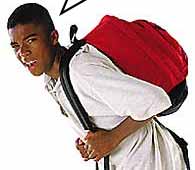

School Children's Backpacks,
Back Pain and Back PathologiesThis section is compiled by Frank M. Painter, D.C.
Send all comments or additions to: Frankp@chiro.org




FROM: Arch Dis Child. 2012 (Aug); 97 (8): 730—732
OPEN ACCESS Rodríguez-Oviedo P, Ruano-Ravina A, Pérez-Ríos M, García FB, Gómez-Fernández D,
Fernández-Alonso A, Carreira-Núñez I, García-Pacios P, Turiso J.
Department of Preventive Medicine and Public Health,
School of Medicine, C/ San Francisco s/n,
University of Santiago de Compostela,
Santiago de Compostela CP 15782,
La Coruña, Spain.OBJECTIVE: To investigate whether backpack weight is associated with back pain and back pathology in school children.
DESIGN: Cross-sectional study.
SETTING: Schools in Northern Galicia, Spain.
PATIENTS: All children aged 12-17.
INTERVENTIONS: Backpack weight along with body mass index, age and gender.
MAIN OUTCOME MEASURES: Back pain and back pathology.
RESULTS: 1403 school children were analysed. Of these, 61.4% had backpacks exceeding 10% of their body weight. Those carrying the heaviest backpacks had a 50% higher risk of back pain (OR 1.50 CI 95% 1.06 to 2.12) and a 42% higher risk of back pathology, although this last result was not statistically significant (OR 1.42 CI 95% 0.86 to 2.32). Girls presented a higher risk of back pain compared with boys.
CONCLUSIONS: Carrying backpacks increases the risk of back pain and possibly the risk of back pathology. The prevalence of school children carrying heavy backpacks is extremely high. Preventive and educational activities should be implemented in this age group.
The Full-Text Article:
INTRODUCTION:
Back pain is currently a health problem of school children which can limit daily-life activities. Sedentary lifestyle is possibly the most important factor determining back pain among school children. According to the 2006 Spanish National Health Enquiry, 11.8% of students aged 10–15 classified themselves as sedentary. [1] Sedentarism along with lack of physical activity contributes to a lower muscular tonicity of the back. Some studies have shown that an individual with back pain in adolescence is more likely to develop low back pain in adult life or that heavy backpacks can cause neck, shoulders and back muscular problems, such as scoliosis. [2, 3] Experts recommend that school children should not carry loads exceeding 10% of their body weight. [4]
The objective of this study is to analyse the infl uence of backpack weight on back pain and back pathologies.
DISCUSSION:
Children carrying the heaviest backpacks have a higher risk of suffering from back pain and a higher risk of back pathology. Most school children carry backpacks exceeding the recommended weights.
Many studies have found that backpacks alter posture and gait signifi cantly, produce modifi cations in the head–neck angle, shoulder asymmetry and even lumbar lordosis. These biomechanical alterations could induce the appearance of chronic pain and back pathologies in the long term.
Between 20% and 45% of young people aged 14–18 have back pain for more than 15 days. A study performed in Northeast England in 2002 showed a low back pain prevalence of 24%, with girls posing a higher prevalence compared with boys. [5] Another study performed in Italy by Negrini and Negrini [3] found that 11-year-old children carried backpacks as heavy as 20% of their body weight, and also that 58.4% had experienced back pain more than once in their lifetime.
Girls are more prone to experience back pain and back pathology than boys, although there are no differences on backpack weight by gender. Grimmer et al [6] observed that girls were more prone to have changes in the craniovertebral angle when carrying a backpack and this association became stronger with age.
The cross-sectional design of the present study is a limitation, as it limits the causal inference of its findings. In this type of study, it is difficult to measure past events such as pain lasting more than 15 days. Other factors that have not been studied such as poor physical fitness, poor back posture, structural scoliosis and hypermobility cannot be excluded as the real cause of back pain. It is possible that backpacks were carried frequently with one strap instead of two with this fact acting jointly with weight in back pain incidence. The strength of this study is the sample size, which allows for precise estimations adjusted by sex, age, body mass index and sports activity.
The results obtained have strong implications. Many children transport excessively loaded backpacks, an excess which would not be allowed for workers in employment. We strongly encourage the medical and educational community to start advising parents and school children about the risks posed by heavy school bags and the fact that this risk can be easily reduced.

Return to BACKPACKS
Return to PEDIATRICS
Return to NECK AND BACK PAIN
Since 9-23-2012


| Home Page | Visit Our Sponsors | Become a Sponsor |
Please read our DISCLAIMER |
